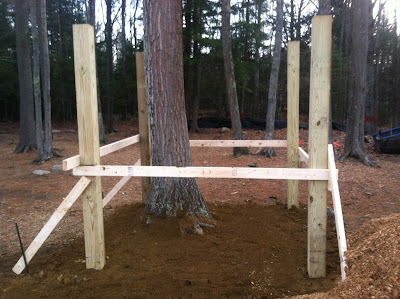So far, we've done a great job of coming up with some interesting, low-cost additions to our playground that focus on natural play. But we always had in mind that we would incorporate a few out-of-the-box pieces when we had the money. Our playground committee's hard work finally paid off this spring when we were finally able to purchase a brand-new climbing net. Yippee!
Climbing nets take up a surprisingly large footprint when you consider the additional eight-foot clearance required around it. The best location we could find was next to our large playground structure, but that required breaking up a section of pavement.
We know--the painted map of the U.S. is gone. We hope to repaint it in the near future, along with more four squares. Since Linkel Construction/Cosmic Stone was already on site to work on our outdoor classroom, they were kind enough to lend their heavy equipment to make the job go much easier.
The spot is all ready for digging!
The climbing net is anchored at five points--each corner, plus the center post. The anchors are set in concrete, which means we needed to dig the holes to a depth of about three feet, then set a plywood box into the hole, which would become the concrete mold. It's a little bit like making five, tiny house foundations.
The first couple of holes went all right, until we hit this massive rock at a mere eighteen inches below the surface. Ledge has been the bane of our playground existence. Mr. Dedek has even considered renaming the school to "Ledgeside". (Not really.) Once again, jackhammers had to be involved.
Thanks to the hard work and ingenuity of Linkel Construction and Rick Schultz, we were able to solve the problem.
Finally, we were able to fill the molds with concrete. Once the concrete was set, the net itself went up within an hour. Once the wood chips were down and the equipment was inspected, it was ready for play!
The kids love it! Thank you to Linkel Construction and our volunteers for all your hard work!

































